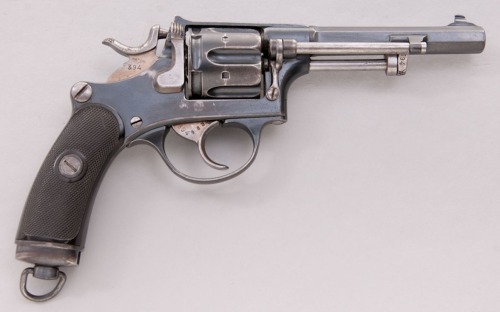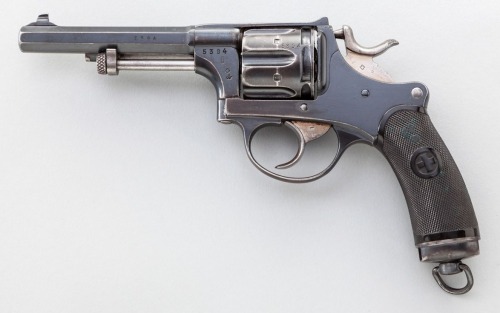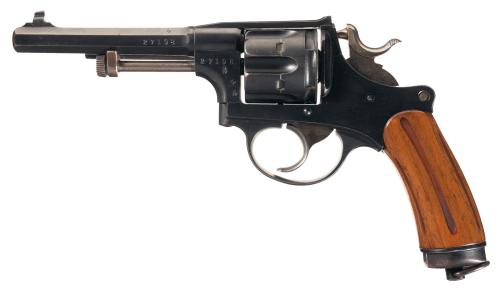schweizerqualitaet:historicalfirearms:Swiss Modell 1882 Ordnance RevolverThe Swiss Ordnance Commisio
schweizerqualitaet:historicalfirearms:Swiss Modell 1882 Ordnance RevolverThe Swiss Ordnance Commision began developing revolvers in the early 1870s, first with the Modell 1872, chambered in 10.4mm rimfire before transitioning to a centrefire cartridge in the Modell 1878. In 1882, Colonel Rudolf Schmidt developed a new revolver chambered in a 7.5mm cartridge, with a cylinder that held six rounds. The design is often mistaken for a variation of Emile Nagant’s revolver, however, the Modell 1882 has more in common with the French Chamelot-Delvigne M1873. It is a double action design with a rebounding hammer and a hinged side plate allowing easy access to the revolver’s lockwork. The Modell 1882 was light, weighing 28oz (0.79kg) and was just over 9 inches (23 cm) in overall length.The pistols loaded and unloaded through a loading gate on the right of the frame. The revolver used Ismael Isaac Abadie’s system where once the gate was open the the cylinder can only be turned by pulling the trigger, the hammer remains stationary while the indexing pawl rotates the cylinder. The user ejected spent casings by manually cycling the ejection rod fixed below the barrel. By 1886, the Swiss Army had equipped all its infantry officers with the Modell 1882. The revolvers was slowly rolled out throughout the Swiss Army for use by cavalry and NCOs, slowly replacing the older 10.4mm revolvers. The pistols were extremely well made by Waffenfabrik Bern. With the first 20,000 revolvers having rubber grips (see images #1 & #2) with a second batch of 17,252 pistols having wooden grips (see image #3 & #4). Bern and SIG also manufactured the pistols for private purchase, the Bern revolvers had a ‘p’ prefix to their serial numbers. In 1901, the Swiss adopted the Luger semi-automatic pistol, however, production of the Modell 1882 continued into the 1930s with a further 18,000 slightly improved Modell 1882/29 made. As the Luger came into frontline service the Swiss continued to issue revolvers to garrison and supply troops, cavalry NCOs and bicycle troops. The Luger initially cost approximately 400 Swiss Francs to manufacture, this was later reduced to 225 Francs, while the revolver was significantly cheaper, costing 120 Swiss Francs. As a result the Modell 1882 remained in service for many years after the Second World War with some sources suggesting the last pistols left service in the 1960s. Sources:Images: 1 2 3 4 Handguns of the World, E.C. Ezell (1981)Swiss Handguns 1872-Present, Swissrifles.com, (source)If you enjoy the content please consider supporting Historical Firearms through Patreon! @cdn-apex-predator I’m really thinking about buying one because I crave the elegance of the lines of that revolver, the simple and effective mechanism and last but not least the fact they are quite cheap in Switzerland - if only ammo was available… -- source link
Tumblr Blog : www.historicalfirearms.info



